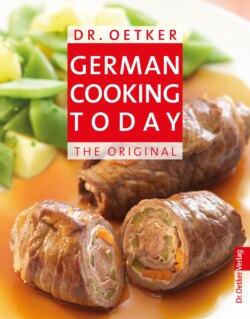Читать книгу German Cooking Today - The Original - Dr. Oetker - Страница 36
На сайте Литреса книга снята с продажи.
ОглавлениеPreparing the meat properly
Meat should always be as fresh as possible when you buy it because it goes bad very quickly as a result of its protein and water content. Do not wash the meat before preparing it; just pat it dry. Then prepare the meat as described in the recipe. If you are not using the meat at once, cover it and store in the refrigerator.
Before cutting the meat into pieces to be served, carefully remove any traces of skin and sinews. Add cooking oil, butter or margarine, depending on the recipe, then heat the pan or skillet until it is very hot and add the meat. When one side has browned, turn the meat over to cook the other side – it is best to do this with tongs (photograph 1) or a spatula, not a fork. In this way you will avoid pricking the meat so the juices will remain inside; it will remain tender and moist as a result.
Cooking the meat properly
» Pan-frying (sautéing): For panfrying it is best to use tender meat from young animals. Usually the meat is cut into individual servings because flat surfaces are better for frying. For a tasty crust, it is recommended that the meat should be seasoned before frying. Important: seasoning with salt should only be done immediately before frying because salt will draw moisture out of the meat which then becomes dried out. Red meat such as beef is fried “au naturel” and may be cooked so as to be more or less done. White meat such as veal or pork can be coated in breadcrumbs or flour and then fried. This makes a beautiful, tasty crust while also preventing the meat from drying out.
» Roasting: When meat is cooked in the oven, it is usually cooked in a roasting tin and, depending on the recipe, with or without a lid. This makes it possible to brown the meat beautifully with or without adding extra fat. Roasting is particularly suitable for large pieces of meat or poultry. It is important to preheat the oven to the temperature indicated in the recipe. Meanwhile fry (sauté) the meat in hot fat in the roasting tin on the stove until brown all over. When the oven is hot enough, put the meat in it on the shelf recommended in the recipe. If the liquid in roasting tin should evaporate, add more. Also baste the meat regularly with the meat juices in the roasting tin to make it even more flavourful.
» Braising: In braising, the meat is cooked on the stove in a pan with the lid on over low heat. First add a little fat to the pan and heat it up. Season the chunks or pieces of meat, put the meat in the hot fat in the pan and brown on all sides. The meat can be cooked with a selection of onions, garlic, carrots, celery, leeks (photograph 2) and tomatoes, depending on the recipe. Add a little water, wine or stock and scrape the cooking residues from the bottom of the pan; then add more liquid until the meat is one-third covered by the liquid. Bring to the boil, then turn the heat down. Season with herbs and spices. Cover the pan and continue cooking over low heat on the stove or in the oven. Turn or stir the meat occasionally during the cooking and, if necessary, add more water, stock or wine, depending on the recipe. The meat is cooked when it feels almost completely soft when you press it. Braising is especially recommended to beginners because precise cooking times are not vital with this method of cooking – half-an-hour too long will do no harm to the meat.
» Testing when it is “done”: The juices exuded by the meat when it is cut will give you an idea of whether it is cooked enough or not. When a
